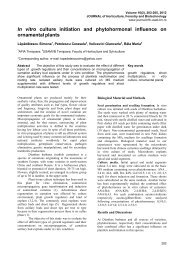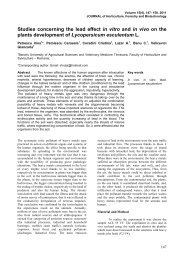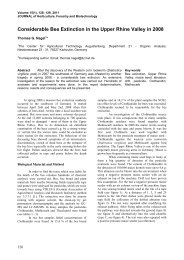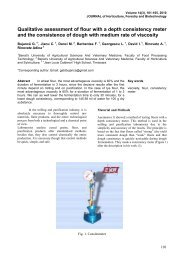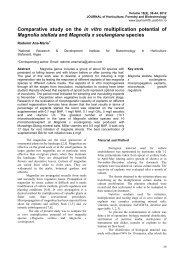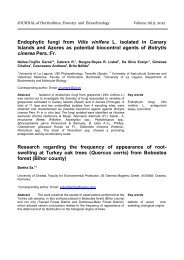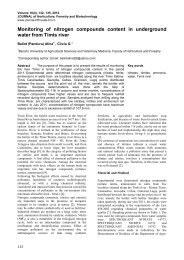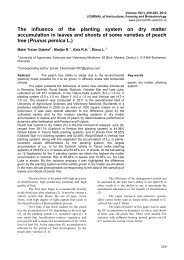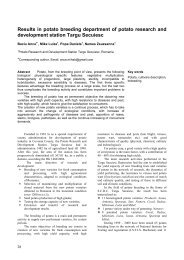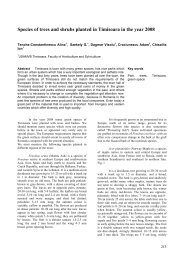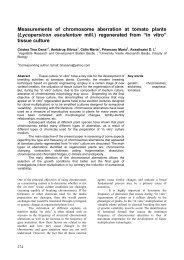evaluation of soil compaction in a high density apple orchard under ...
evaluation of soil compaction in a high density apple orchard under ...
evaluation of soil compaction in a high density apple orchard under ...
Create successful ePaper yourself
Turn your PDF publications into a flip-book with our unique Google optimized e-Paper software.
Evolution <strong>of</strong> <strong>soil</strong> <strong>compaction</strong> state <strong>in</strong> a <strong>high</strong> <strong>density</strong> <strong>apple</strong><strong>orchard</strong> <strong>under</strong> the <strong>in</strong>fluence <strong>of</strong> technological trafficIancu Mihail 1* , Tebeica A. 11 Research Institute for Fruit Grow<strong>in</strong>g Pitesti - Romania*Correspond<strong>in</strong>g author. Email: <strong>of</strong>fice@icdp-pitesti.roAbstract To quantify the effects achieved by the ma<strong>in</strong>tenance themowed sod strips system between tree rows <strong>in</strong> a <strong>high</strong> <strong>density</strong> <strong>apple</strong> <strong>orchard</strong>,located on a slop<strong>in</strong>g land, <strong>in</strong> the period 1978 – 2004, some studies werecarried out. It was organized an experience with the follow<strong>in</strong>g three factors:Factor A = <strong>soil</strong> type, with 3 graduations, Factor B = the year s<strong>in</strong>ce treesplant<strong>in</strong>g where, the <strong>in</strong>vestigations were made with two graduations and FactorC = technological traffic with three graduations.On average, on the three <strong>soil</strong> types and the two periods <strong>of</strong> time s<strong>in</strong>ce treesplant<strong>in</strong>g, except the depth <strong>of</strong> 5-10 cm, <strong>in</strong> the other three <strong>soil</strong> depths analyzed,CI 1 and CI 3 , versus CI 2 , related to BD and RP, generally showed significantly<strong>high</strong>er values. Under the same conditions, the above <strong>in</strong>dices related to K satgenerally showed significantly lower values. On average, on the three <strong>soil</strong>types over 4 year period s<strong>in</strong>ce trees plant<strong>in</strong>g compared to 20 year periods<strong>in</strong>ce their plant<strong>in</strong>g, on depth <strong>of</strong> 5-10 cm, value <strong>of</strong> the three <strong>compaction</strong><strong>in</strong>dices related to BD was significantly <strong>high</strong>er by 10%, and those related toRP, by 74%. Instead, <strong>under</strong> the same conditions, on the depth <strong>of</strong> 55-60 cm,the value <strong>of</strong> the three <strong>compaction</strong> <strong>in</strong>dices related to BD was significantlyreduced by 9%, and those l<strong>in</strong>ked to RP, by 71%. In l<strong>in</strong>e with the abovepresented, on average on the three <strong>soil</strong> types, <strong>in</strong> 20 years period s<strong>in</strong>ce treesplant<strong>in</strong>g compared to 4 year period s<strong>in</strong>ce their plant<strong>in</strong>g, at 15-20 cm depth,the value <strong>of</strong> the three <strong>compaction</strong> <strong>in</strong>dices related to K sat was significantlygreater with 326%.Key words<strong>soil</strong> erosion, technologicaltraffic, <strong>high</strong> <strong>density</strong> <strong>apple</strong><strong>orchard</strong>The execution <strong>of</strong> technological traffic requiredby the ma<strong>in</strong>tenance <strong>of</strong> <strong>high</strong> <strong>density</strong> <strong>apple</strong> <strong>orchard</strong>causes a differential <strong>soil</strong> <strong>compaction</strong> on the <strong>in</strong>tervalsbetween rows. The studies conducted <strong>in</strong> this regardhave shown the disposition mode and the <strong>in</strong>tensity withwhich this process is done <strong>in</strong> relatively short periods <strong>of</strong>time s<strong>in</strong>ce trees plant<strong>in</strong>g, both <strong>in</strong> <strong>orchard</strong>s located onflat terra<strong>in</strong>s (Gras, 1965, Iancu and Neamtu, 1979), andthose located on slop<strong>in</strong>g lands (Iancu, 2001). In thispaper we <strong>in</strong>tended to <strong>high</strong>light the differentialmanifestation <strong>of</strong> this process on two moments locatedwith<strong>in</strong> a relatively long period <strong>of</strong> time from treesplant<strong>in</strong>g (20 years). To do this, dur<strong>in</strong>g 1978 – 2004,some <strong>in</strong>vestigations were carried out at the Research -Institute for Fruit Grow<strong>in</strong>g Pitesti - Mărăc<strong>in</strong>eni.Material and MethodThe <strong>in</strong>vestigations were carried out <strong>in</strong> a <strong>high</strong><strong>density</strong> <strong>apple</strong> <strong>orchard</strong> established <strong>in</strong> 1984 on a hillsidewith a length <strong>of</strong> 200 m and a slope <strong>of</strong> 6-12% <strong>in</strong> thestudied area. The tree rows were placed on the generaldirection <strong>of</strong> the contour l<strong>in</strong>es, with the distancebetween them <strong>of</strong> 3.6 m and between trees along therow <strong>of</strong> 1.5 m. The tractor used for works had a totalweight <strong>of</strong> 2.1 t. The distance between the externaledges <strong>of</strong> the rear motor wheels was 1.72 m, while that<strong>of</strong> the front wheels was 1.63 m. When perform<strong>in</strong>g plantsanitary treatments, it was used a carried spray<strong>in</strong>gmach<strong>in</strong>e with a total weight <strong>of</strong> about 1.5 t. Soil fromthe <strong>in</strong>tervals between tree rows were ma<strong>in</strong>ta<strong>in</strong>ed as 2.4– 2.6 m wide, mowed sod strips, performed by sow<strong>in</strong>g<strong>of</strong> Lollium perenne. On the tree row direction, the <strong>soil</strong>was worked mechanically on a 0,8 – 1 m band width.It was organized the follow<strong>in</strong>g experimentalscheme: A factor – <strong>soil</strong> type, with graduations: a 1 =eutricombosol with coluvic character (ECC); a 2 =,slightly eroded eutricombosol (SEE); a 3 = tipiceutricombosol (TE); B factor - period (years) after treeplant<strong>in</strong>g, with graduations: b 1 = 4 (1978), b 2 = 20(2004); Factor C -technological traffic. With<strong>in</strong> the<strong>in</strong>terval between two tree rows, as a result <strong>of</strong>technological traffic, four different zones <strong>of</strong><strong>compaction</strong> were achieved (fig. 1). To <strong>high</strong>light thedevelopments <strong>in</strong> the state <strong>of</strong> <strong>soil</strong> <strong>compaction</strong> on these217
zones, the <strong>compaction</strong> <strong>in</strong>dex was calculated. It is theratio <strong>of</strong> the three <strong>compaction</strong> zones located on the<strong>in</strong>terval between tree rows and <strong>compaction</strong> zonesituated on the tree row axis. Thus the follow<strong>in</strong>ggraduations <strong>of</strong> experimental C factor were established:A- Interval between two tree rows.1. Weakly compacted zone (tree row);2. Strongly compacted zone (wheel trace placed <strong>in</strong> the lower part <strong>of</strong> the <strong>in</strong>terval between two tree rows)3. Strongly compacted zone placed <strong>in</strong> the upper part <strong>of</strong> the <strong>in</strong>terval between two tree rows;4. Medium compacted zone (middle distance <strong>of</strong> the <strong>in</strong>terval between two tree rows;Fig. 1. Location <strong>of</strong> the four <strong>soil</strong> <strong>compaction</strong> zones between two tree rowsc1 = the ratio between strongly compactedzone situated on the wheel trace located downstream <strong>of</strong>the <strong>in</strong>terval between tree rows and weakly compactedzone located on the tree row axis – <strong>compaction</strong> <strong>in</strong>dex 1(CI 1 );c2 = the ratio between medium compactedzone located <strong>in</strong> mid-<strong>in</strong>terval between tree rows andweakly compacted zone situated on the tree row axis -<strong>compaction</strong> <strong>in</strong>dex 2 (CI 2 );c3 = the ratio between strongly compactedzone situated on the trace located upstream <strong>of</strong> the<strong>in</strong>terval between tree rows and weakly compacted zonelocated on the tree row axis – <strong>compaction</strong> <strong>in</strong>dex 3(CI 3 ). These three <strong>in</strong>dices were calculated for each <strong>of</strong>the three physical properties analyzed. Therefore, toidentify them, physical property short name wasattached to each <strong>of</strong> them.Soil samples were taken, <strong>in</strong> 4 replications, frompr<strong>of</strong>iles located on each <strong>compaction</strong> zone <strong>in</strong>dicated <strong>in</strong>Fig. 1. Samples unchanged <strong>in</strong> structure, were collectedon depths <strong>of</strong> 5-10 cm, 15-20 cm, 35-40 cm and 55-60cm. It was determ<strong>in</strong>ed the bulk <strong>density</strong> (BD), thesaturated hydraulic conductivity (K sat ) and resistance topenetration (RP).Results and Discussion‣ Influence <strong>of</strong> experimental factors onthe value <strong>of</strong> ratios between the technologicaltraffic zones concern<strong>in</strong>g the physical propertiesanalyzedOn average, on the 2 periods <strong>of</strong> time from treesplant<strong>in</strong>g, the average <strong>of</strong> the 3 <strong>compaction</strong> <strong>in</strong>dices (CI 1 ,CI 2 and CI 3 ) <strong>of</strong> bulk <strong>density</strong> (BD) on the SEE and ET<strong>soil</strong>s versus ECC <strong>soil</strong>, were significantly <strong>high</strong>er by 6-8% on depths <strong>of</strong> 15-20 cm and 35-40 cm and nonsignificant on 55-60 cm depth. Instead, on the depth <strong>of</strong>5-10 cm, ECC - SEE <strong>soil</strong>s , versus TE <strong>soil</strong>, the average<strong>of</strong> the same three <strong>compaction</strong> <strong>in</strong>dices <strong>of</strong> bulk <strong>density</strong>were significantly <strong>high</strong>er by 10%. Under the sameconditions, the value <strong>of</strong> the three <strong>compaction</strong> <strong>in</strong>dices <strong>of</strong>saturated hydraulic conductivity (K sat ), on the ET <strong>soil</strong>,versus SEE <strong>soil</strong> was three times significantly <strong>high</strong>er atthe depth <strong>of</strong> 5-10 cm and 1.75 times at the depth <strong>of</strong> 15-20 cm. Also, on the depth <strong>of</strong> 15-20 cm, on ECC <strong>soil</strong>versus the SEE <strong>soil</strong>, the value <strong>of</strong> the three <strong>compaction</strong><strong>in</strong>dices <strong>of</strong> K sat was seven times significantly <strong>high</strong>er.Compared to the value <strong>of</strong> the three <strong>compaction</strong> <strong>in</strong>dicesrelated to BD and K sat , the same <strong>in</strong>dices value relatedto resistance to penetration (RP) not significantlydifferentiated the three <strong>soil</strong> types at any <strong>of</strong> the four <strong>soil</strong>depths analyzed.On average, on the three <strong>soil</strong> types, <strong>in</strong> 4th yearafter trees plant<strong>in</strong>g versus 20th year, on the depth <strong>of</strong> 5-10 cm, the value <strong>of</strong> the three <strong>compaction</strong> <strong>in</strong>dicesrelated to BD was significantly <strong>high</strong>er by 10% and thethree <strong>compaction</strong> <strong>in</strong>dices related to RP by 74%.Instead, <strong>under</strong> the same conditions, on the depth <strong>of</strong> 55-218
60 cm, the three <strong>compaction</strong> <strong>in</strong>dices related to BD wassignificantly reduced by 9%, and those related to RP,by 71%. The values <strong>of</strong> <strong>compaction</strong> <strong>in</strong>dices related toK sat have registered <strong>in</strong> l<strong>in</strong>e with those presented above,respectively the <strong>compaction</strong> <strong>in</strong>dices related to the bulk<strong>density</strong>. Thus, on the 15-20 cm depth, the value <strong>of</strong>three <strong>compaction</strong> <strong>in</strong>dices related to K sat wassignificantly greater with 326% at 20 years s<strong>in</strong>ce treesplant<strong>in</strong>g compared to the 4 year period s<strong>in</strong>ce theirplant<strong>in</strong>g.On average, on the three <strong>soil</strong> types and the twoperiods <strong>of</strong> time from trees plant<strong>in</strong>g, except the depth <strong>of</strong>5-10 cm, on the other three <strong>soil</strong> depths analyzed CI 1and CI 3 , versus CI 2 , related to the BD and PR recordedgenerally significantly <strong>high</strong>er values and respectivelylower concern<strong>in</strong>g K sat .Influence <strong>of</strong> technological traffic on the <strong>soil</strong> <strong>compaction</strong> state <strong>in</strong> a <strong>high</strong> <strong>density</strong> <strong>apple</strong> <strong>orchard</strong>Table 1ReportedB FactorA Factor graduastionsSoil depth <strong>soil</strong>graduastionsC Factor graduastions(cm) physicalLSD5LSD5a1 a2 a3b1 b2property%%c1 c2 c3 LSD%5-10 1 1,22 1,21 1,10 0,065 1,23 1,12 0,071 1,18 1,15 1,19 NS2 0,46 0,40 1,20 0,545 0,65 0,72 NS 0,58 0,80 0,69 NS3 4,40 3,19 2,74 NS 4,38 2,51 0,798 3,88 2,89 3,56 0,56415-20 1 1,03 1,12 1,10 0,051 1,11 1,06 NS 1,11 1,07 1,06 0,042 4,71 0,67 1,17 2,84 0,83 3,54 1,97 2,13 2,35 2,07 NS3 2,36 2,25 2,56 NS 2,76 2,02 NS 2,68 2,24 2,25 NS35-40 1 1,05 1,12 1,10 0,057 1,06 1,12 NS 1,07 1,07 1,12 0,0372 1,05 0,55 1,16 NS 0,92 0,92 NS 0,82 1,28 0,66 0,3753 2,07 2,34 2,04 NS 1,77 2,52 0,295 2,05 1,85 2,54 0,34155-60 1 1,06 1,12 1,11 NS 1,05 1,14 0,075 1,12 1,11 1,06 0,0342 0,98 0,44 0,68 NS 0,91 0,50 NS 0,79 0,78 0,54 NS3 1,51 1,94 2,19 NS 1,39 2,37 0,407 2,14 1,62 1,90 0,315Soil physical property: 1= bulk <strong>density</strong>; 2= Saturated hydraulic conductivity; 3= resistance to penetrationThe significance <strong>of</strong> A, B, C experimental factor graduations is presented <strong>in</strong> chapter „Material and Method”‣ Influence <strong>of</strong> <strong>soil</strong> type on the value <strong>of</strong>ratios between the technological trafficzones concern<strong>in</strong>g the physical propertiesanalyzed. (Interaction <strong>of</strong> experimentalfactors A/C)For the three <strong>soil</strong> physical properties<strong>in</strong>vestigated and four <strong>soil</strong> depths analyzed, the number<strong>of</strong> cases <strong>in</strong> which the three <strong>compaction</strong> <strong>in</strong>dices weresignificantly different between them was the <strong>high</strong>est onECC <strong>soil</strong> (30.6% <strong>of</strong> cases analyzed ) followed by TE<strong>soil</strong> (25%), and SEE <strong>soil</strong> was located on the last place(19%). For the three <strong>soil</strong>s and four depths analyzed, thenumber <strong>of</strong> cases <strong>in</strong> which the three <strong>compaction</strong> <strong>in</strong>diceswere significantly different was the <strong>high</strong>est (28% <strong>of</strong>cases analyzed) for BD, followed by RP (25%) and K satwas on the last place (22%). For the three <strong>soil</strong> typesand the three physical properties analyzed, the number<strong>of</strong> cases <strong>in</strong> which the three <strong>compaction</strong> <strong>in</strong>dices weresignificant different was equal at 35-40 cm and 55-60cm depths (30% <strong>of</strong> cases analyzed ) followed by 5-10cm depth (26%), and 15-20 cm depth was located onthe last place (15%) - Table 2For the three <strong>soil</strong> physical properties studied andthe four <strong>soil</strong> depths, <strong>compaction</strong> <strong>in</strong>dex 2 recorded the<strong>high</strong>est number <strong>of</strong> cases <strong>in</strong> which it was significantlydifferent between the three <strong>soil</strong> types exam<strong>in</strong>ed (17%<strong>of</strong> the total number <strong>of</strong> cases). Under the sameconditions, the <strong>compaction</strong> <strong>in</strong>dices 2 and 3 registeredan equal number <strong>of</strong> cases that have significantdifferences, only 11%.For the four <strong>soil</strong> depths analyzed, the number <strong>of</strong>cases <strong>in</strong> which the three <strong>in</strong>dices <strong>of</strong> <strong>compaction</strong> weresignificantly different between the three <strong>soil</strong> types wasrecorded for BD (31% <strong>of</strong> the total number <strong>of</strong> cases)followed by K sat (8%). Under the same conditions, the<strong>compaction</strong> <strong>in</strong>dices related to RP were not significantlydifferent <strong>in</strong> any case (Table 2).For the three physical properties studied, thenumber <strong>of</strong> cases where the <strong>compaction</strong> <strong>in</strong>dices weresignificantly different between the three <strong>soil</strong> typesoccurred at the 5-10 cm shallow depth (22% <strong>of</strong> casesexam<strong>in</strong>ed). On the depths <strong>of</strong> 15-20 cm and 35-40 cm,this number was similar, represent<strong>in</strong>g 15% <strong>of</strong> the totalnumber <strong>of</strong> calculated cases. At 55-60 cm depth, therewas no case <strong>of</strong> significant differentiation <strong>of</strong> the three<strong>compaction</strong> <strong>in</strong>dices (Table 2).219
The <strong>in</strong>fluence <strong>of</strong> <strong>soil</strong> type on the values <strong>of</strong> ratios between technological traffic zonesconcern<strong>in</strong>g studied physical propertiesTable 2Soildepth(cm)Reported<strong>soil</strong>physicalpropertya1 a2 a3 LSD 5%c1 c2 c3 c1 c2 c3 c1 c2 c3 e f5-10 1 1,26 1,13 1,25 1,23 1,18 1,21 1,05 1,15 1,10 0,064 0,1132 0,44 0,48 0,47 0,56 0,45 0,19 0,73 1,46 1,41 0,461 0,9453 5,26 3,51 4,43 3,34 2,70 3,55 3,05 2,46 2,69 0,977 NS15-20 1 1,08 1,01 1,00 1,15 1,10 1,09 1,11 1,10 1,09 0,062 0,0892 5,16 4,66 4,32 0,45 0,78 0,79 0,78 1,62 1,11 NS NS3 2,33 2,48 2,27 2,48 1,94 2,33 3,23 2,28 2,16 0,800 NS35-40 1 1,00 1,01 1,14 1,11 1,11 1,13 1,11 1,10 1,09 0,065 0,0992 0,93 1,57 0,66 0,79 0,54 0,33 0,76 1,72 0,99 0,649 NS3 2,14 1,85 2,21 2,38 1,60 3,03 1,64 2,11 2,36 0,590 NS55-60 1 1,08 1,08 1,02 1,13 1,13 1,09 1,14 1,12 1,08 0,059 NS2 1,06 1,24 0,64 0,57 0,40 0,35 0,74 0,69 0,62 0,545 NS3 1,80 1,27 1,48 1,70 1,70 2,44 2,92 1,88 1,77 0,545 NSReported <strong>soil</strong> physical property: 1 = bulk <strong>density</strong>; 2 = saturated hydraulic conductivity; 3 = resistance to penetrationLSD 5%: e= constant a, c different; f = constant c,‣ Influence <strong>of</strong> period <strong>of</strong> time from treesplant<strong>in</strong>g on the value <strong>of</strong> ratios between thetechnological traffic zones concern<strong>in</strong>g thephysical properties analyzed.(Interaction <strong>of</strong>experimental factors B/C)For the three physical properties <strong>under</strong> study andfour <strong>soil</strong> depths analyzed, the number <strong>of</strong> cases <strong>in</strong> whichthe three <strong>compaction</strong> <strong>in</strong>dices were significantlydifferent between them was at 20 years from treesplant<strong>in</strong>g (33% <strong>of</strong> total analyzed cases) compared to theperiod <strong>of</strong> time located at 4 years <strong>of</strong> their plant<strong>in</strong>g(25%). For the two periods from trees plant<strong>in</strong>g and four<strong>soil</strong> depths analyzed, the number <strong>of</strong> cases <strong>in</strong> which thethree <strong>compaction</strong> <strong>in</strong>dices were significantly differentbetween them was <strong>high</strong>est for RP (33% <strong>of</strong> all casesanalyzed ), followed by BD (25%), and K sat was on thelast place (21%). For the two periods from treesplant<strong>in</strong>g and the three physical properties <strong>in</strong> the study,the number <strong>of</strong> cases <strong>in</strong> which the three <strong>compaction</strong><strong>in</strong>dices were significantly different between them, wassimilar to the depths <strong>of</strong> 5-10 cm and 35-40 cm (33 % <strong>of</strong>the total number <strong>of</strong> analyzed cases), the 55-60 cm <strong>soil</strong>depth was ranked second (22%) and 15-20 cm <strong>soil</strong>depth, was situated on the last place (17%).For the three <strong>soil</strong> physical properties studied andthe four <strong>soil</strong> depths analyzed, <strong>compaction</strong> <strong>in</strong>dex 1recorded the <strong>high</strong>est number <strong>of</strong> cases <strong>in</strong> which it wassignificantly different between the two periods fromthe trees plant<strong>in</strong>g (33% <strong>of</strong> the total number <strong>of</strong> cases).For the <strong>compaction</strong> <strong>in</strong>dex 3, this number was 25% andfor <strong>compaction</strong> <strong>in</strong>dex 2, there was no case <strong>of</strong>significant difference.For the four <strong>soil</strong> depths analyzed, the number <strong>of</strong>cases <strong>in</strong> which the three <strong>compaction</strong> <strong>in</strong>dices weresignificantly different between the two periods s<strong>in</strong>cetrees plant<strong>in</strong>g was <strong>high</strong>est for RP (42% <strong>of</strong> the totalnumber <strong>of</strong> cases). For the two other <strong>soil</strong> physicalproperties (K sat and BD), this number was similar (8%).For the three <strong>soil</strong> physical properties <strong>under</strong>study, the number <strong>of</strong> cases <strong>in</strong> which the three<strong>compaction</strong> <strong>in</strong>dices significantly differed between thetwo periods s<strong>in</strong>ce trees plant<strong>in</strong>g was <strong>high</strong>est on 5-10cm depth (33% <strong>of</strong> the analyzed cases). The 35-40 cm<strong>soil</strong> depth was ranked secondly (16%), the 55-60 cm<strong>soil</strong> depth was situated on 3 rd place, and the depth <strong>of</strong> 15to 20 cm, on the last place, where there was no case <strong>of</strong>significant differentiation.220
Influence <strong>of</strong> time period s<strong>in</strong>ce m trees plant<strong>in</strong>g on the values <strong>of</strong> ratios betweentechnological traffic zones concern<strong>in</strong>g the studied physical propertiesTable 3Soildepth(cm)Reported<strong>soil</strong>physicalpropertyb1 b2 LSD5%c1 c2 c3 c1 c2 c3 e f5-10 1 1,25 1,21 1,23 1,11 1,10 1,14 0,1222 0,74 0,82 0,38 0,41 0,78 0,99 0,377 0,4763 5,28 3,25 4,60 2,49 2,52 2,51 0,798 1,38215-20 1 1,12 1,11 1,10 1,11 1,03 1,02 0,051 NS2 0,50 1,11 0,89 3,75 3,60 3,26 NS NS3 3,17 2,33 2,79 2,19 2,14 1,72 0,653 NS35-40 1 1,03 1,07 1,09 1,12 1,08 1,15 0,053 NS2 0,88 1,07 0,79 0,77 1,48 0,53 0,530 NS3 1,64 1,50 2,17 2,46 2,21 2,90 0,482 0,51155-60 1 1,06 1,06 1,03 1,17 1,17 1,10 0,049 NS2 1,16 0,80 0,76 0,42 0,75 0,32 NS NS3 1,64 1,31 1,23 2,64 1,92 2,56 0,445 0,705Reported <strong>soil</strong> physical property: 1 = bulk <strong>density</strong>; 2 = saturated hydraulic conductivity; 3 = resistance to penetrationLSD 5% e = constant b, c different; f = constant c, b differentIn the present study and other previous works(Iancu, 2001, Iancu and Tebeica, 2010), to <strong>high</strong>lightthe evolution <strong>of</strong> <strong>soil</strong> <strong>compaction</strong> <strong>under</strong> the <strong>in</strong>fluence <strong>of</strong>technological traffic some <strong>in</strong>dices <strong>of</strong> <strong>compaction</strong> statehave used. They represented the ratios between the<strong>compaction</strong> zones caused by the technological traffic,concern<strong>in</strong>g the <strong>soil</strong> physical properties analyzed.Data presented <strong>in</strong> tables 1-3, showed firstly that,on the traces left by the wheels <strong>of</strong> agriculturalequipment dur<strong>in</strong>g the technological traffic, comparedto the zone located on the tree row axis and even on thezone located <strong>in</strong> mid-<strong>in</strong>terval between trees rows, it hasbeen registered a worsen<strong>in</strong>g <strong>of</strong> <strong>soil</strong> physical condition.This process <strong>of</strong> deterioration on the more superficial<strong>soil</strong> layers (5-10 cm, 15-20 cm) was more evident <strong>in</strong> 4years s<strong>in</strong>ce trees plant<strong>in</strong>g compared to the period <strong>of</strong> 20years s<strong>in</strong>ce their plant<strong>in</strong>g. This improvement <strong>in</strong> time <strong>of</strong><strong>soil</strong> physical state <strong>in</strong> the superficial layers can beexpla<strong>in</strong>ed by the ameliorative effect <strong>of</strong> herbs with<strong>in</strong> the<strong>soil</strong> moved strip system between tree rows. In contrast,<strong>in</strong> the analyzed <strong>soil</strong> layers located deeper (35-40 cmand 55-60 cm), the degree <strong>of</strong> <strong>soil</strong> <strong>compaction</strong> was<strong>high</strong>er at 20 years from trees plant<strong>in</strong>g compared to theperiod <strong>of</strong> 4 years s<strong>in</strong>ce their plant<strong>in</strong>g. Therefore thesef<strong>in</strong>d<strong>in</strong>gs show that, the technological traffic <strong>in</strong> <strong>high</strong><strong>density</strong> <strong>apple</strong> <strong>orchard</strong>s, produces an <strong>in</strong>crease <strong>of</strong> <strong>soil</strong><strong>compaction</strong> state over time. However, at the top <strong>of</strong> the<strong>soil</strong>, this process <strong>of</strong> physical deterioration is reduced byherbs with<strong>in</strong> the <strong>soil</strong> mowed sod strips system. Of thethree physical properties determ<strong>in</strong>ed, RP wassignificantly different <strong>in</strong> most cases, <strong>in</strong> the issues listedabove. It was followed by BD, and K sat was situated onthe last place.Conclusions1. On average, on the three <strong>soil</strong> types and thetwo periods <strong>of</strong> time from trees plant<strong>in</strong>g, except thedepth <strong>of</strong> 5-10 cm, <strong>in</strong> the other three <strong>soil</strong> depthsanalyzed, CI 1 and CI 3 , versus CI 2 , related to BD andRP, generally showed significantly <strong>high</strong>er values.Under the same conditions, the above <strong>in</strong>dices related toK sat generally showed significantly lower values.2. On average, on the three <strong>soil</strong> types, over theperiod <strong>of</strong> 4 years s<strong>in</strong>ce trees plant<strong>in</strong>g compared to theperiod over <strong>of</strong> 20 years s<strong>in</strong>ce their plant<strong>in</strong>g, on depths<strong>of</strong> 5-10 cm, value <strong>of</strong> the three <strong>compaction</strong> <strong>in</strong>dicesrelated to BD was significantly <strong>high</strong>er by 10%, andthose related to RP, by 74%. Instead, <strong>under</strong> the sameconditions, on the depth <strong>of</strong> 55-60 cm, the value <strong>of</strong> thethree <strong>compaction</strong> <strong>in</strong>dices related to BD wassignificantly reduced by 9%, and those l<strong>in</strong>ked to RP,by 71%.3. In l<strong>in</strong>e with the above presented, on averageon the three <strong>soil</strong> types, <strong>in</strong> the period over 20 year s<strong>in</strong>cetrees plant<strong>in</strong>g compared to the 4 year period s<strong>in</strong>ce theirplant<strong>in</strong>g, at 15-20 cm depth, the value <strong>of</strong> the three<strong>compaction</strong> <strong>in</strong>dices related to K sat was significantlygreater with 326%.References1. Gras, R, 1965, Premiers resultants d’un essaid’entretien du sol en arboriculture fruitiere. Action surles properties physiques du sol. Ann. Agron. 16: 663-700.221
2. Iancu M., 2001, Influence <strong>of</strong> Technological Trafficon Soil Physical Properties Depend<strong>in</strong>g în Natural orAnthropic Factors în Orchards. Proceed<strong>in</strong>gs 3 rdworkshop Incocopernicus Concerted Action Buşteni –Romania.3. Iancu M. and I. Neamţu, 1979. Cercetări priv<strong>in</strong>dtasarea solului într-o livadă <strong>in</strong>tensivă de măr. Lucr.Simpozionului de Cercetări asupra relaţiei sol-apăplantăcu aplicaţii în proiectarea şi amplasareasistemelor de irigaţie: 265:287.4. Iancu M., Tebeică A. (2010). Influence <strong>of</strong> positionwith<strong>in</strong> the terraces platform on some physicalproperties <strong>in</strong> case <strong>of</strong> three <strong>soil</strong> types <strong>in</strong> a <strong>high</strong> <strong>density</strong><strong>apple</strong> <strong>orchard</strong>, In these proceed<strong>in</strong>gs.222



